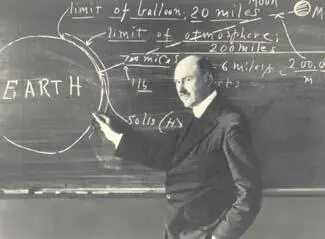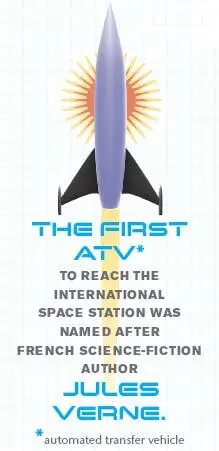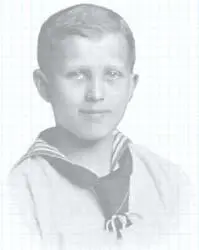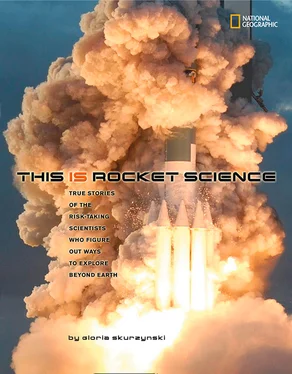Halfway around the world, just four years before Tsiolkovsky published his “Reaction Devices” article, 17-year-old Robert Hutchings Goddard climbed a cherry tree behind the barn of his Massachusetts home. A year earlier, in 1898, Goddard had read H. G. Wells’s science fiction novel The War of the Worlds. Perhaps its scenes about invaders from Mars lingered in his mind, because he later wrote that on that day, “I imagined how wonderful it would be to make some device which had even the possibility of ascending to Mars, and how it would look…if sent up from the meadow at my feet….”

ROBERT GODDARD BELIEVED THAT LIQUID-FUEL ROCKETS COULD FLY AS FAR AS THE MOON.
At Clark University Robert Goddard received a Ph.D. in physics and set up an experiment to prove that rockets could fly in a vacuum, which most people doubted. He built a chamber, removed all the air from it, put a small rocket inside, and fired it. This experiment convinced him that rockets could not only fly in a vacuum, but also achieve up to 20 percent more thrust in a vacuum than in air because there was no air resistance to reduce the rocket’s thrust.

Goddard had ideas about fuel, too. Unaware of Tsiolkovsky’s article, Goddard believed that liquid propellant was a higher-energy fuel that created more thrust than solid propellant did. In solid-fuel rockets the grain (the propellant charge) is densely packed and molded inside a casing. Goddard understood the disadvantages of liquid propellants—they’re harder to handle than solid propellants like gunpowder. Also, the two components, fuel and oxidizer, have to be kept in separate tanks until launch, and liquid oxygen (the oxidizer) must be stored at a very low temperature, near –300°F. But the advantage of liquid propellants is that during flight, the rate at which they’re injected into the combustion chamber can be increased or decreased or shut off if necessary, while solid fuels burn until they’re completely used up. Goddard would have liked to combine LH 2with LOX, but LH 2was hard to come by. Instead, he used gasoline combined with LOX for his rocket experiments.
“PROFESSOR GODDARD…SEEMS TO LACK THE KNOWLEDGE LADLED OUT DAILY IN HIGH SCHOOLS.”
NEW YORK TIMES
In 1920 Goddard published a paper titled “A Method for Reaching Extreme Altitudes.” It claimed that if a rocket was large enough and had fuel that was powerful enough, it could reach the Moon. The press ignores most academic papers, but the New York Times happened to see this one and responded by ridiculing Dr. Goddard’s theory about flights in a vacuum. The Times insisted that space travel was impossible because unless a rocket had an atmosphere to push against, it couldn’t move at all: “That Professor Goddard…does not know the relation of action to reaction, and of the need to have something better than a vacuum against which to react—to say that [about reaching the Moon] would be absurd. [He] seems to lack the knowledge ladled out daily in high schools.” It didn’t matter that the New York Times was wrong and Goddard was right; Goddard felt humiliated. He moved to New Mexico and continued his rocket research away from the public eye.
Across the Atlantic a young German tried to recover from his country’s defeat in World War I. Like Tsiolkovsky, Hermann Oberth had been fascinated as a boy by Jules Verne’s novel From the Earth to the Moon. He said later that he’d read it “at least five or six times and, finally, knew [it] by heart.” Oberth realized that some of Verne’s ideas were not just science fiction, but real science. At age 14 Oberth designed a model rocket. He had no way to test it, but he delved into mathematics to teach himself propulsion theories.
After the war Oberth studied physics. In 1923 he wrote a paper called “By Rocket into Planetary Space,” and in 1929, in a longer version of the paper, he forecast “rockets…so [powerful] that they could be capable of carrying a man aloft.” In a footnote Oberth mentioned Goddard’s “A Method for Reaching Extreme Altitudes.”
Russia not only had lived through World War I but also had survived a turbulent revolution that increased its territory and gave rise to a new name: Union of Soviet Socialist Republics, or Soviet Union for short. When the Soviet newspaper Izvestia mentioned Oberth’s publication, Tsiolkovsky read it and saw the reference to Goddard’s work, which he hadn’t heard about. Tsiolkovsky decided to republish his own early articles about space travel and include with them a number of his newer theories.
PROFESSOR HERMANN OBERTH, (TO THE RIGHT OF THE LARGE ROCKET), GATHERS MEMBERS OF HIS DESIGN TEAM FOR A TEST FIRING. STUDENT WERNHER VON BRAUN IS SECOND FROM RIGHT.
These three scientists have been called the Fathers of Modern Rocketry. They never met and at first were unaware of each others’ ideas about rocket propulsion, yet they independently came to pretty much the same conclusions. All believed in the superiority of liquid fuels for rocket propulsion. Their research on liquid propellants inspired two men who would become key players in the 1950s space race between two superpowers.
Not long after Oberth wrote his “Planetary Space” paper, 13-year-old Wernher von Braun tied six skyrockets to a toy wagon and lit them. Belching smoke and flame, the little red wagon roared five blocks through a crowded Berlin street and then exploded. In the uproar that followed, police grabbed the boy and kept him in the police station until his furious father came to get him out.
His father’s anger didn’t put an end to von Braun’s fascination with rockets. Like so many other budding rocket scientists, he’d read the science fiction of Jules Verne and H. G. Wells. But he’d also read Oberth’s paper, which inspired him to learn calculus and trigonometry so he could understand the physics of rocketry. Later, as von Braun studied for his Ph.D. at the University of Berlin, he worked as an assistant to Professor Oberth, and in 1932 von Braun and a few other men began designing liquid-fuel rockets for the German military.

WERNHER VON BRAUN
In 1936 von Braun became technical director of Germany’s military rocket program. Soon, he and his team launched two liquid-fuel rockets that went a mile and a half high. Shortly after that, the Soviets, who’d also been working with liquid propulsion, fired a rocket that soared more than eight miles into the sky. And a month later, one of Robert Goddard’s rockets flew faster than the speed of sound. Von Braun and his team read about this in journals and used some of Goddard’s ideas in their own designs.
During World War II German military commanders, under the rule of Adolf Hitler, wanted to use rockets as deadly weapons of war—military missiles that could deliver explosive warheads onto enemy territory.
As has been true with all other rockets since the first fire arrows, no one person can be credited with the entire design of the German rocket. Tsiolkovsky, Oberth, and others had envisioned elements of this kind of rocket. Goddard had already launched his own version of a liquid-fuel rocket. Von Braun and his fellow rocket scientists worked at developing theirs at a facility named Peenemunde. As the war went on, it was hard for von Braun and his crew to find petroleum products, but German farms were producing bumper crops of potatoes. Potatoes can be distilled into ethyl alcohol. By combining ethyl alcohol with liquid oxygen, the German “Rocket Team” had what they needed. By 1944 they’d nearly perfected the deadly Vengeance Weapon 2 rocket, shortened to V-2. It had a 200-mile range and carried a 2-ton warhead.
Читать дальше















